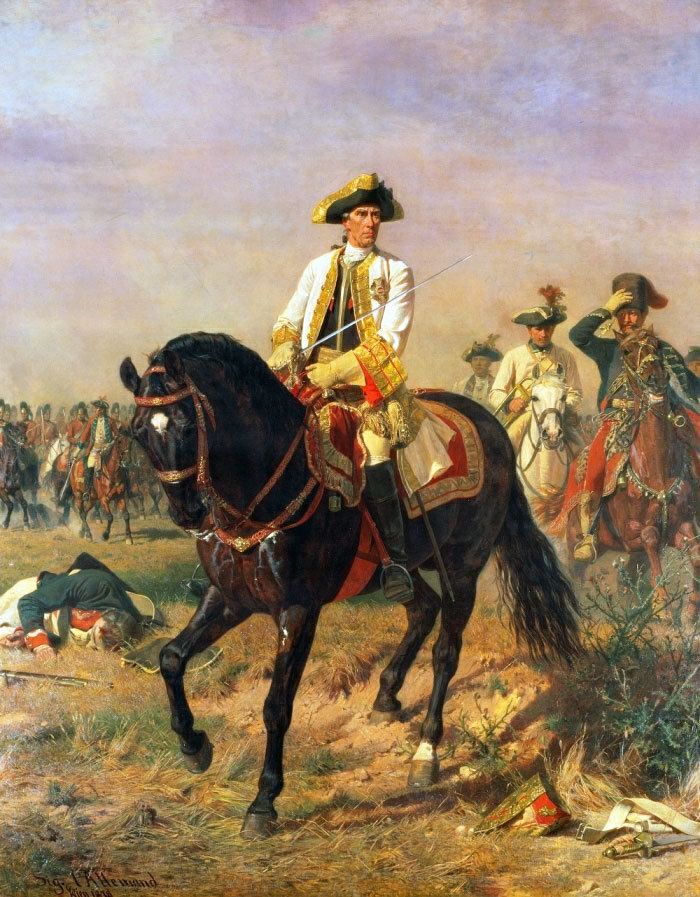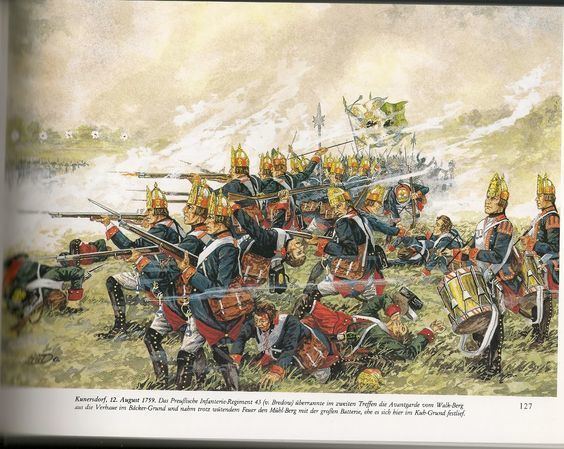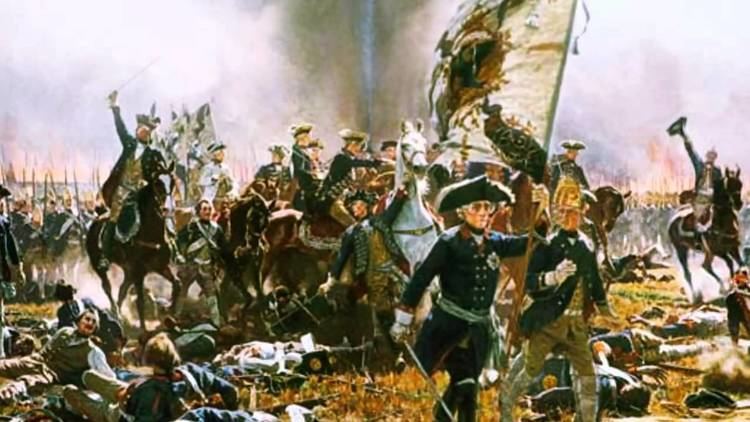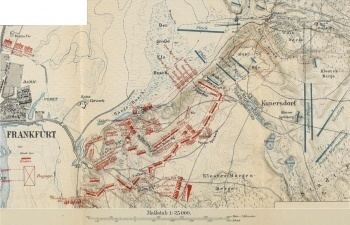Date 12 August 1759 | Result Russo-Austrian victory | |
 | ||
50,900230 guns 59,500Russian 41,000 soldiers, including 5,200 cavalryAustrian 18,523, including 248 guns 19,10027 banners2 standards172 guns Combatants Kingdom of Prussia, Russian Empire, Habsburg Monarchy Similar Seven Years' War, Battle of Zorndorf, Battle of Gross‑Jägersdorf, Battle of Leuthen, Battle of Rossbach | ||
Seven years war battle of kunersdorf
At the Battle of Kunersdorf, in the Seven Years' War on 12 August 1759, near Kunersdorf (Kunowice), east of Frankfurt an der Oder, more than 100,000 men clashed in a decisive battle. A combined allied army commanded by Pyotr Saltykov and Ernst Gideon von Laudon included 41,000 Russians and 24,000 Austrians defeated Frederick the Great's army of 50,900 Prussians. Only 3,000 soldiers from Frederick's original 50,900 comprising the Prussian army returned to Berlin after the battle, though many more had only scattered and rejoined the army afterward. This represented the penultimate success of the Russian Empire under Elizabeth of Russia and arguably was Frederick's worst defeat.
Contents
- Seven years war battle of kunersdorf
- Battle of kunersdorf
- Situation in Seven Years War
- Dispositions
- Battle
- Cavalry attack
- Aftermath
- Assessment
- References

Battle of kunersdorf
Situation in Seven Years' War

By 1759, Prussia had reached a strategic defensive position in the war; Russian and Austrian troops surrounded Prussia, although not quite on the borders. Upon leaving winter quarters in April 1759, Frederick assembled his army in Lower Silesia; this forced the main Habsburg army to remain in its staging army in Bohemia. The Russians, however, shifted their forces into western Poland, a move that threatened the Prussian heartland, Brandenburg, and potentially Berlin itself. Frederick countered by sending an army corps, commanded by Friedrich August von Finck, to contain the Russians. Finck's efforts were defeated at the Battle of Kay, on 23 July. Subsequently, the Russian forces, commanded by Pyotr Saltykov, advanced the 110 kilometers (68 mi) to occupy Frankfurt, Prussia's second largest city, on 31 July. There he ordered entrenchment of their camp to the east, near Kunersdorf. To make matters worse for the Prussians, an Imperial corps of 19,200 soldiers, commanded by Ernst Gideon von Laudon, joined them on 5 August. King Frederick rushed from Saxony, took over the remnants of Lieutenant General Carl Heinrich von Wedel's contingent at Müllrose and moved across the Oder River. By the time he had marched the 37 km (23 mi) to Kunersdorf, his forces had been enhanced by Finck's defeated corps, and another corps moving to the Lausitz region: by 9 August, he had 49,000 troops.
Dispositions

The terrain surrounding Kunersdorf suited itself well to defense. A stream, the Hühner-Fliess, flowed in a depression beyond these hills northwesterly toward the Oder. Two other depressions intersected the ridge, creating three distinct promontories. The western portion was a 3 km (2 mi) stretch from the Juden-Berge in the southwest to the highest ground in the area, the Grosser Spitzberg and its outcropping in the northeast. A narrow depression, known as the Kuhgrund, lay beyond that. After the Kuh-grund, the ground rose again into another hill, called Mühl-Berge. Beyond this lay a second depression known as Bäcker-grund, then a slight rise known as the Walk-Berge. There was additional high ground to the east of Kunersdorf, called the Kleiner Spitzberg.

Saltykov crossed the Oder on the same day as Frederick, and knew of Frederick's movements. He established his troops on a strong position from which to receive the Prussian attack. Saltykov entrenched himself in a position running from the Juden-Berge through the Grosser Spitzberg to the Mühl-Berge, and faced his troops to the south east. He and the Austrian troops were stretched along a ridge of small hills that ran north-easterly from the outskirts of Frankfurt to just north of the village of Kunersdorf (present day Kunovice). He had little concern about the northwestern face of the ridge, which was steep and fronted by a swampy ground called the Elsbruch, but a few of the Austrian contingents to his right faced northwest as a precaution. He knew that the Frederick had crossed the Oder south of Frankfurt and would attack from the southeast.

The Prussians reached the area north of the Hühner Fliess on 11 August. Frederick conducted a perfunctory reconnaissance of his enemy's position, but did not send scouts to reconnoiter the land or question locals about the ground; instead, he decided that all the Allies were facing northwest. He placed a diversionary force, commanded by Finck, at the Hühner Fliess, which would apparently threaten the northeastern portion of the Allied position, and marched his main army around to the south east This way, he thought he would surprise his enemy, forcing the Allied army to reverse fronts, a fairly complicated maneuver, and Frederick could employ his much feared oblique battle order, feigning with his left flank as he did so. Ideally, this would allow him to roll up the Allied line from the Muhl-Berge. Both armies had been reinforced by smaller units; by the time of the battle, the Allied forces had about 60,000 men, with another 5,000 holding Frankfurt, and the Prussians had almost 51,000.
Battle

It started at 2:00 am on 12 August with an 8-hour Prussian march around the Russian and Austrian positions. This constituted Frederick's first blunder: the King exhausted his already tired men on a forced march to face the enemy where it was strongest. Early in the march, Frederick realized that he was actually facing his enemy, instead of approaching behind them. Furthermore, a row of ponds forced him to break his line, exposing it to greater fire power, and diminishing its impact. Instead of a broad frontal attack, Frederick was forced to deploy his men into three narrow columns. He changed his dispositions; the Prussians would concentrate east of the ponds of Kunersdorf, and make an assault on the Mühl-Berge. Frederick calculated that he could turn the Austrian-Russian flank. His redeployment took time, and the apparent hesitation in the assault confirmed to Saltykov what Frederick was planning.
As the Prussians approached, their own artillery batteries created an arc of artillery fire on the Russian sector by the Walk-Berge and the Kleiner Spitzberg. Shuvalov's Observation Corps, stationed on the Mühl-Berge, took substantial losses—perhaps 10 percent—and the Prussian grenadiers overwhelmed them at 11:30 am. Saltykov sent grenadiers to shore them up but the Prussians carried the Mühl-Berge, capturing 80 enemy cannon, which they deployed against the Russians. The Prussian position, despite this success, was not substantially better than a few hours earlier. To complete Frederick's battle plan, the Prussians would have to descend to the lower Kuh-grund, cross the field, and then assault a well-defended higher ground.
The King's brother, Prince Henry, and several other Prussian generals encouraged Frederick to stop there. The Prussians held the high ground between the Austro-Russian force and Frankfurt. To descend into the valley and ascend against frightful fire was foolhardy, they argued. Furthermore, the weather was blistering hot, and the troops had endured forced marches to reach the battle field. They had not had a hot meal in several days, having bivouacked the night before without fires. However, Frederick wanted to press his initial success and decided to continue the fight. He transferred his artillery to the Mühl-Berge, and ordered Finck's battalions to assault the Allied salient from the north-west, while his main strike would cross the Kuh-grund ravine. This was his second blunder.
Saltykov was ready for him and had reinforced the salient with reserves from the west and southwest; these reserves most of Loudon's infantry. Finck made no progress at the salient and the Prussia attack at the Kuh-grund were thwarted with murderous fire along a very narrow front. Once, despite the fierce fighting, it looked like the Prussians might break through, but gradually the Allied superiority (423 artillery pieces) could be brought to bear on the Prussians as they struggled up the hill, and the Allied grenadiers held their lines. Watching from the luxury of the Kleiner Spitzberg, Saltykov judiciously fed in reinforcements from other sectors.
Cavalry attack
The battle culminated in the early evening hours with a massive Prussian cavalry charge led by General Friedrich Wilhelm von Seydlitz upon the Russian center and artillery positions. The Prussian cavalry suffered heavy losses from cannon fire and retreated in complete disorder. Seydlitz himself was badly wounded and, in his absence, Lieutenant General Dubislav Friedrich von Platen assumed command. Platen organized the last-ditch effort. His scouts had discovered a suitable crossing past the chain of ponds south of Kunersdorf, but would have to deal with the artillery batteries on the Grosser Spitzberg. Seydlitz, wounded but still following the action, noted that it was foolish to charge a fortified position with cavalry. His assessment was correct. The units sent against the position shattered; before any further action could take place, Loudon himself led the Austrian cavalry's counter-attack and routed Platen's cavalry. The fleeing men and horses trampled their own infantry around the Mühl-Berge. General panic ensued.
At this point the battle was lost: two of Frederick's initiatives, his cavalry attack across the Fleiss and his attack on the Kuh-grund, already had failed. His third initiative, the cavalry attack against fortified positions, had failed. His infantry had been on its feet for 16 hours, half of that in a forced march over muddy and uneven terrain, and the other half in slogging battle against formidable odds.
Seeking the coup de grâce, Saltykov threw his own Cossack and Kalmyk (cavalry) into the fray. Frederick, in the middle of the action, was surrounded by the Chuggavieski Cossacks. His own horse was killed, his uniform was torn, and a snuff-box in his pocket was pulverized. He stood on a small hill with the remnants of his body-guard—the Leib Cuirassier—determined to either hold the line or to die trying. With a 100-strong Hussar squadron, Rittmeister (cavalry captain) Joachim Bernhard von Prittwitz-Graffron cut his way through the Cossacks and dragged the King to safety.
Aftermath
The Russians and Austrians lost about 15,000 men (approx. 5,000 killed), although some sources suggest a slightly higher number, perhaps 15,600 or 15,700. The Prussians lost about 19,000. Gaston Bodart estimates at the high end; Christopher Clark estimates at the low end. Regardless the specific number, Russian and Austrian losses were at about 26 percent, which is high for the 18th century. The Prussians suffered a severe defeat, losing 172 of their own cannons plus an additional 105 that they had captured from the Russians in the late morning on the Muhl-Berge; as well as 6,000 killed and 13,000 wounded, for a casualty rate of more than 37 percent. They also lost 27 flags and two standards.
The Prussians lost their entire horse artillery, an amalgam of cavalry and artillery in which the entire crews rode horses into battle, one of Frederick's notable inventions. An additional 26,000 men—most of the survivors—were scattered over the territory between Kunersdorf and Berlin; by the end of the battle itself, Frederick thought he had 3,000 men capable of mounting any kind of organized resistance. Four days after the battle, most of the 26,000 scattered men turned up at the headquarters on the Oder River or in Berlin, and Frederick's army recovered to a strength of 32,000 men and 50 cannon. Furthermore, following the battle, the victorious Cossack troops committed (unspecified) atrocities against the population.
The storming of field works usually results in a disproportionate number of killed over wounded. The conclusion of the battle in hand-to-hand struggle also increased casualties on both sides. Finally, subsequent cavalry charges and their stampeding flight, caused many more injuries. Of men lost, on the Russian side, half were killed; on the Prussian side, two-thirds of the casualties were deaths. The Prussians also lost 60% of their cavalry, killed or wounded. Frederick lost six regimental colonels. Of his senior command, Seydlitz was wounded and had to relinquish command to Platen; General Carl Heinrich von Wedel was badly enough wounded that he never fought again; General Georg Ludwig von Puttkamer, commander of the Puttkamer Hussars, lay among the dead,. Also among the dead lay Major Ewald Christian von Kleist, the famous poet of the Prussian army. Prince Charles Anton August von Holstein-Beck died (12 September) of his wounds, as did Lieutenant General August Friedrich von Itzenplitz (5 September) and Major General v. Klitzing (28 October), in Stettin.
The defeat remained without consequences when the victors did not capitalize on the opportunity to march against Berlin but retired to Saxony instead. Frederick considered this omission the "Miracle of the House of Brandenburg" in a letter to his brother Henry on 1 September. The Russian army would no longer fight any major battle, allowing the Prussians to focus on the Austrians. Elizabeth of Russia continued her policy of support to Austria, considering it vital to Russian interests, but with decreasing effectiveness. Distance constrained the Russian supply lines and, despite Austrian headquarters agreement to supply the Russian troops through their own lines, Russian troops took little part in the remaining battles of 1759 and 1760. The Russians did manage to capture the fortress at Kolberg in 1761, their sole success; Prussia was at its last gasp and Frederick despaired of preserving much of his remaining kingdom for his heir, the 10-year-old Frederick William. The death of Elizabeth, and the ascension of her nephew, Peter, an admirer of Frederick's, saved the Prussian Kingdom. Peter immediately withdrew Russia from hostilities against Prussia.
Assessment
Most military historians agree that Kunersdorf was Friedrich's greatest, and most catastrophic, loss. They attribute it variously to his indifference to the Russian practices of the "art of war", to his lack of information about the ground, and his inability to realize that the Russians had, effectively, surmounted the obstacles of location. Frederick had made limited efforts to assess the terrain: the Russians and the Austrians had discovered a causeway between the lakes and the marshland that allowed them to present Frederick with a united front. This effectively cancelled any advantage Frederick could muster with the use of the oblique battle order. Furthermore, the Russians utilized a naturally defensive position that forced the Prussians to employ clumsy tactics. Despite the murderous fire, though, Frederick's troops eventually turned the Russian left, but to little benefit since the terrain allowed the Russians and Austrians to form a compact front shielded by the hills and marshes.
Perhaps Frederick most egregious mistake was his refusal to consider the recommendations of his trusted staff. Prince Henry reasonably suggested to halt the battle at mid-day on the 12th, after the Prussians had secured the first height. From this vantage point, they would be unassailable, and eventually, the Austro-Russian force would have to withdraw. Instead of holding his secure position, Frederick forced his tired troops to descend the hill, cross the low ground, and ascend the next hill, in the face of heavy fire. The subsequent Prussian cavalry effort was badly coordinated and, despite an initial success that drove back the Russian and Austrian squadrons, the fierce cannon and musketry fire from the united Allied front inflicted staggering losses on Frederick's much-vaunted cavalry. Furthermore, he committed perhaps the gravest of errors in sending his cavalry into battle piecemeal, and against entrenched positions.
Sources differ on the losses, but generally agree that Frederick lost between 19,000 and 25,000 killed wounded and captured and the Russians lost about 15,000. Most importantly, Saltykov and Loudon left the field with intact armies, and with extant communications between one another. Frederick was not so fortunate: he estimated he had less than 5,000 men capable of offering any sort of resistance. The king wrote to Berlin to Karl Wilhelm von Finckensten, on the evening after the battle:
This morning at 11 o'clock I have attacked the enemy. ... All my troops have worked wonders, but at a cost of innumerable losses. Our men got into confusion. I assembled them three times. In the end I was in danger of getting captured and had to retreat. My coat is perforated by bullets, two horses of mine have been shot dead. My misfortune is that I am still living ... Our defeat is very considerable: To me remains 3,000 men from an army of 48,000 men. At the moment in which I report all this, everyone is on the run; I am no more master of my troops. Thinking of the safety of anybody in Berlin is a good activity ... It is a cruel failure that I will not survive. The consequences of the battle will be worse than the battle itself. I do not have any more resources, and—frankly confessed—I believe that everything is lost. I will not survive the doom of my fatherland. Farewell forever!
Frederick complicated his own fate by violating every principle of war he had espoused in his own writing, particularly the one on reconnaissance. On the basis of meager information and almost no understanding of the ground, he had thrown his infantry into the teeth of gun fire; he compounded this folly by committing his cavalry piecemeal in pointless charges. Although he had matured considerably since the disaster at Mollwitz in 1741, he still acted on ground of his enemy' choosing, not his own. Langer and Pois suggest, though, that he violated all his own rules because he was facing an enemy he despised, and this brought out the worst of his generalship.
